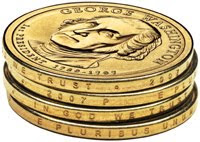Last March, the Government Accountability Office, the investigative research arm of the legislative branch, issued a report with the alliterative title “Replacing the $1 Note with a $1 Coin Would Provide a Financial Benefit to the Government” (GAO-11-281 [PDF]). The report opens by saying that “According to GAO’s analysis, replacing the $1 note with a $1 coin could save the government approximately $5.5 billion over 30 years. This would amount to an average yearly discounted net benefit—that is, the present value of future net benefits—of about $184 million.”
In 2008, I posted a similar analysis of the benefit of using “Paper v. Coin Dollars” with the political reasons of that time as to why the paper dollar would continue to be printed. Although the political landscape have changed, the will of the politicians to make this change does not exist.
Last month, a coalition that includes Brink’s, Inc., independent car wash operators, and public transportation officials responded against the GAO report citing the alleged logistical issues and increased costs in handling a dollar coin versus paper.
 On their side opposing the sole use of a $1 coin is the Department of the Treasury and the Federal Reserve. They cite the differences in the weight and the public’s attachment to the paper dollar. In a USA Today/Gallup poll conducted in 2006 found that while 54-percent thought the Presidential $1 Coin thought the program was a good idea, 79-percent said that they do not want the coins to replace the paper dollar.
On their side opposing the sole use of a $1 coin is the Department of the Treasury and the Federal Reserve. They cite the differences in the weight and the public’s attachment to the paper dollar. In a USA Today/Gallup poll conducted in 2006 found that while 54-percent thought the Presidential $1 Coin thought the program was a good idea, 79-percent said that they do not want the coins to replace the paper dollar.
 The political and economic environment has change. The GAO’s report bolstered the Dollar Coin Alliance, who has reportedly spent $250,000 to lobby congress since December. With the emphasis on the budget, a plan to find ways to generate revenues with little political risk has the concept of eliminating the paper dollar being taken seriously. This has the anti-coin dollar coalition worried.
The political and economic environment has change. The GAO’s report bolstered the Dollar Coin Alliance, who has reportedly spent $250,000 to lobby congress since December. With the emphasis on the budget, a plan to find ways to generate revenues with little political risk has the concept of eliminating the paper dollar being taken seriously. This has the anti-coin dollar coalition worried.
Another factor working against the anti-coin dollar advocates is the loss of a major ally in congress. The late Senator Ted Kennedy (D-MA) did not want to see the paper dollar eliminated because it would hurt the Dalton, Mass. based Crane & Co.. Crane is the sole supplier of currency paper that the Bureau of Engraving and Printing uses to produce the one dollar note. John Olver (D-MA) represents the the Massachusetts First Congressional District that includes Dalton.
Although the political environment favors the elimination of the paper dollar, the risk adverse members of congress will look at the 2006 poll and probably not vote to eliminate the paper dollar. Unless key congressional leaders agree that ending the printing of the one-dollar note is in the best interests of everyone, including their political careers, the political reality is that printing of the dollar note is here to stay.
Dollar note image courtesy of the Bureau of Engraving and Printing
Dollar coin image courtesy of the U.S. Mint

